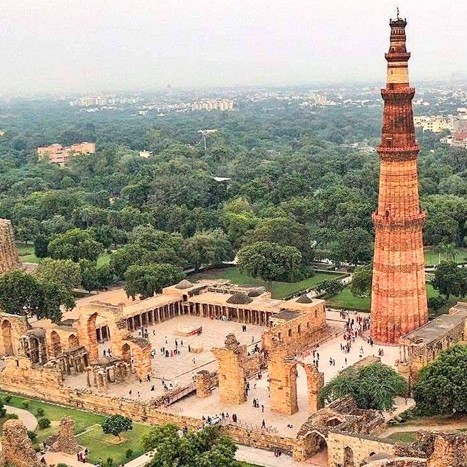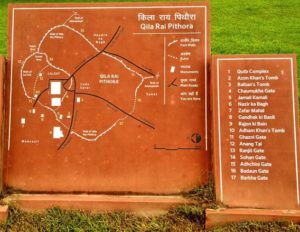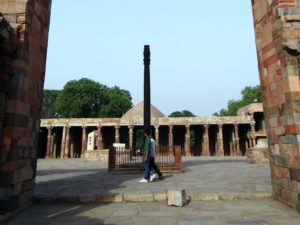A sneak-peak into the pre-Sulatanate history of the Qutub Complex.
Pre-Sultanate History Of The Qutub Complex

Among the many historical monuments and archaeological remains in the NCT of Delhi, the most notable, both in antiquity and arresting design, is the Qutub complex, a name given to the group of monuments including the Quwwat-ul-Islam Mosque, the lofty Qutub Minar, the tomb of Iltutmish, the Alai Minar, Alai Darwaza, the madrasa, the tomb of Alauddin Khalji & others.1
The evidence from the Qutub archaeological area of 8th-9th century sculptures, inscriptions, including the ‘Iron Pillar Inscription’, and architectural fragments suggests that the area was known as ‘Yoginipura’ during the Gupta, post-Gupta, and Pratihara periods, and then became known as ‘Dhilli’ or ‘Dhillika’ after the Tomars built ‘Lal Kot’.2 Tomar Rajputs constructed Lal Kot, Delhi’s first Red Fort, in the 11th century. Later, Prithviraj-III constructed a new fort on a hill near Lal Kot named ‘Qila Rai Pithora,’ which surrounded the Lal Kot fortress on three sides. Thus, Dhillika’s medieval metropolis consisted of ‘Lal Kot’ and ‘Qila Rai Pithora’ in Mehrauli.
The rampart walls of Lal Kot were 20 to 30 feet thick and still stand towering and majestic today. It should be noted that the Qutub complex was part of the ‘Lal Kot and Qila Rai Pithora’ complex (refer Figure-1). The remains of various Hindu and Jain temples are quite evident in the Qutub area. After Qila Rai Pithora, Delhi was the site of a succession of cities. Each city functioned as the capital, fortress, or center of a vast domain. When Sultan Alauddin Khalji took over as ruler, he originally resided at Qila Rai Pithora, which was deemed safer. Siri Plain was mostly utilized for military purposes.3

(Figure 1: Plan showing ramparts of Lal Kot and Qila Rai Pithora. Qutub complex (marked as 1) is enclosed by ramparts of Lal Kot.)
The inscriptional evidence at Quwwat-ul-Islam Mosque in the Qutub complex states that it was built with materials from 27 idol temples, each of which cost twice a thousand into thousand Diliwals. Furthermore, the inscription informs that after the fortress (Lal Kot and Qila Rai Pithora) was conquered, the Quwwat-ul Islam Masjid was built.4 According to historian Sunil Kumar, the Quwwat-ul Islam Masjid was previously known as Masjid-i Jami in Persian writings. By the thirteenth century, Delhi had earned the appellation Qubba al-Islam (The Dome or Sanctuary of Islam), which may have inspired the name of the mosque: Quwwat-ul Islam. The Persian text Tajul-Ma’asir also mentions the construction of Quwwat-ul Islam Masjid: “Qutubuddin built the Jami Masjid at Delhi, and adorned it with the stones and gold obtained from the temples which had been demolished by elephants, and covered it with inscriptions in Toghra, containing the divine commands”.5
In the courtyard of the Quwwat-ul Islam mosque stands the famous ‘Iron Pillar’ of Delhi which bears a Brahmi inscription, and calls ‘Iron Pillar’ as Vishnu Dhvaja (“विष्णुपदे गिरौ भगवतो विष्णोर्ध्वजः स्थापितः“). This inscription, palaeographically assignable to 4th century CE, also names a powerful king called Chandra identified as Chandragupta-II of Imperial Guptas. The pillar has been brought here evidently from somewhere else, as no other relics of the fourth century are found at the site. There is a strong bardic tradition that it was brought here by Anangpal, the Tomar King, who is credited with the founding of Delhi (Dhillika).
The base of the pillar is knobby, with small pieces of iron tying it to its foundations, and a lead sheet covers the portion concealed below the present floor level.6 Many inscriptions were done on the Iron Pillar in later years. Later Nagari inscriptions on the iron pillar are dated: 1052 CE, 1515 CE, 1523 CE, 1710 CE, 1826 CE, and 1831 CE. The first of these inscriptions is dated 1052 CE (VS 1109), or at least 600 years after the first inscription praising King Chandra, i.e., after the 4th century CE. It records “Samvat Dihali 1109 Ang Pal bahi” meaning – in Samvat 1109 Anangpal founded Delhi.7

(Figure 2: Iron Pillar standing in the courtyard of Quwwat-ul Islam Masjid.)
When it comes to the Qutub Minar, there is a lot of debate over this spectacular structure. The Nagari inscriptions on the minar refer to it as ‘Kirtistambha’ of Malikdin and ‘Jayastambha’ of Alauddin. Furthermore, Historian Pushpa Prasad has noted that the three Nagari inscriptions dated VS 1256 (1199 CE) on the ground storey of the Qutub Minar is suggestive of the fact that the erection of the Qutub Minar began in 1199 CE. No dated Arabic or Persian inscription is found on the Qutub Minar earlier than 1199 CE. In any case, it may be presumed from these three inscriptions that the base of the structure of the Minar had been laid out as early as 1199 CE.
There is yet another inscription in Nagari script found on the jamb of the main entrance door in the ninth course of the Qutub Minar mentioning: “Pirthi Nirap.” This inscription records the name of a reigning king. It is presumed that “Pirthi” here refers to the Chauhan Rajput ruler Prithviraj.8 R.N. Munshi opined that the inscriptional evidence on the Minar couldn’t conclude that Qutubuddin Aibak constructed the minar. He further states that it was completed during the reign of Iltutmish, based on inscriptions and literary writings, and renovated, afterward, under the reigns of Feroz Shah and Sikander Lodi.9 Therefore, based on the three Nagari inscriptions dated 1199 CE (discussed previously), it is generally assumed that the foundation and the first storey of Qutub Minar were built by Qutubuddin Aibak in 1199 CE and Iltutmish completed the remaining three storeys. Thus, originally there were only four storeys in Qutub Minar.10
We infer from the foregoing discussion that the Qutub complex was a part of the medieval city of Dhillika, within the fort complex of Lal Kot and Qila Rai Pithora, as supported by extant evidence at the historical site. Later, it was refurbished by Muslim Sultans and repurposed in the form of masjids and tombs. In fact, the publication of the Archaeological Survey of India (Book: Qutb Minar and Adjoining Monuments) clearly recognizes this fact in the following lines: “The picturesque area around the Qutub Complex and Mehrauli, where the rocky outspur of the Delhi Ridge is scattered with ruins, is the site of the oldest of Delhi’s many cities. Here one can see the ramparts of Qila Rai Pithora, the city built by the Rajput king, Prithviraj Chauhan, who expanded Lal Kot, the citadel of another Rajput clan, the Tomars.”
References
- Mitra, 2002, Qutub Minar & adjoining monuments, Archaeological Survey of India, pp. 26-27
- Mani, 1992, Puratattva: Bulletin of the Indian Archaeological Society, Number 22, p. 75
- Varma, 2016, Romancing Delhi from Lal Kot to Shahjahanabad, Archaeological Survey of India, pp. 8-26
- Munshi, 1911, The History of the Kutb Minar, pp. 53-54
- Elliot & Dowson, 1869, The History of India as told by its own Historians, p. 222
- Sharma, 2001, Delhi and its Neighbourhood, Archaeological Survey of India, p. 55-56
- Pande, 2006, Qutb Minar and its Monuments, p. 30
- Prasad, 1990, Sanskrit Inscriptions of Delhi Sultanate 1191-1526, pp. 1-3
- Munshi, 1911, The History of the Kutb Minar, pp. 60-61
- Pande, 2006, Qutb Minar and its Monuments, p. 34

Leave a Reply